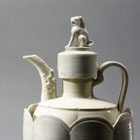J.J. Lally & Co., Oriental Art / New York City, New York
MenuPast Exhibition
Chinese Porcelain and Silver in the Song Dynasty
March 18 - April 8, 2002
13.
A WHITE PORCELAIN EWER AND COVER WITH
WARMING BASIN, CUPS AND CUPSTANDS
Liao/Northern Song Dynasty, A.D. 10th/11th Century
the ewer with well potted melon-lobed body, raised on a wide ring foot with knife-pared rim, the narrow cylindrical neck with an arched triple-stranded strap handle attached low on one side opposite a slender curving spout which rises up from the jaws of a moulded dragon head emerging from the flat shoulder of the vessel, the cylindrical cover fitting over the neck, surmounted by a seated lion finial and pierced with two holes for attachment to the handle; the warming basin thinly potted with deep sides formed of eight lobes rising to a petal-carved rim with indented border, the base sharply angled and raised on a tall splayed foot with neatly rounded rim, showing some kiln grit from firing on the unglazed base, the interior base with an unglazed wide ring; the cup stands each centered with a rounded cylindrical platform applied on top with a flaring rim, rising from an integral circular tray supported on a high hollow flaring foot pierced with three quatrefoil apertures, the plain white cups of shallow circular form, one with flaring sides and moulded lip, the other of lipless form with rounded sides; the vessels and stands all made from high-fired white porcelain covered with a clear glaze.
Height of ewer and basin overall 11 1⁄2 inches (29.2 cm)
Compare the glazed white porcelain ewer and cover with warming basin of related but less elaborate form, excavated in Hebei in 1974, illustrated in Zhongguo Wenwu Jinghua Daquan, Taocijuan (Compendium of Chinese Archaeological Treasures, Ceramics), Hong Kong, 1993, p. 315, no. 490, ascribed there to the Liao dynasty. Another glazed white porcelain ewer of more closely related form, with dragon-head moulded spout and lion-top cover, was exhibited at the Nezu Institute of Fine Arts, Tokyo, in 1993 and illustrated in the catalogue entitled White Porcelain of Ding yao, p. 10, no. 106.
Although wine ewers of this type were most often made with a warming basin, it is rare to see a set surviving intact. A white porcelain ewer of related form, carved with lotus petals and peony scroll decoration, but lacking the cover and basin, is illustrated by Krahl in Chinese Ceramics from the Meiyintang Collection, London, 1994, p. 208, no. 369, where the author suggests an attribution to the Ding kilns in Hebei province. Another carved white porcelain ewer of similar form, also lacking the cover and basin, from the Calmann Collection, now in the Musée Guimet, Paris, is illustrated in Oriental Ceramics, The World's Great Collections, Vol. VII, Tokyo, 1981, col. pl. III.
Ewers and basins of this type are more frequently seen in Yingqing porcelain. Compare, for example, the Yingqing ewer and basin in the Jiangxi Provincial Museum which was excavated in 1965 from a tomb dated to A.D. 1057, illustrated by Addis in Chinese Ceramics from Datable Tombs, London, 1978, p. 22, fig. 14. Another Song Yingqing porcelain ewer and basin set from the Eumorfopoulos Collection, now in the British Museum, is illustrated by Tregear, Song Ceramics, London, 1982, p. 146, no. 193. Other Song dynasty kilns also produced similar wine serving vessel sets. Compare the Yaozhou celadon covered ewer with matching cups and cupstands in the Meiyintang Collection, illustrated by Krahl, op. cit., p. 227, nos. 401 and 402.
The form of the ceramic ewer and basin sets is derived from silver prototypes. Compare, for example, the silver-gilt ewer and basin set, catalogue no. 12.
